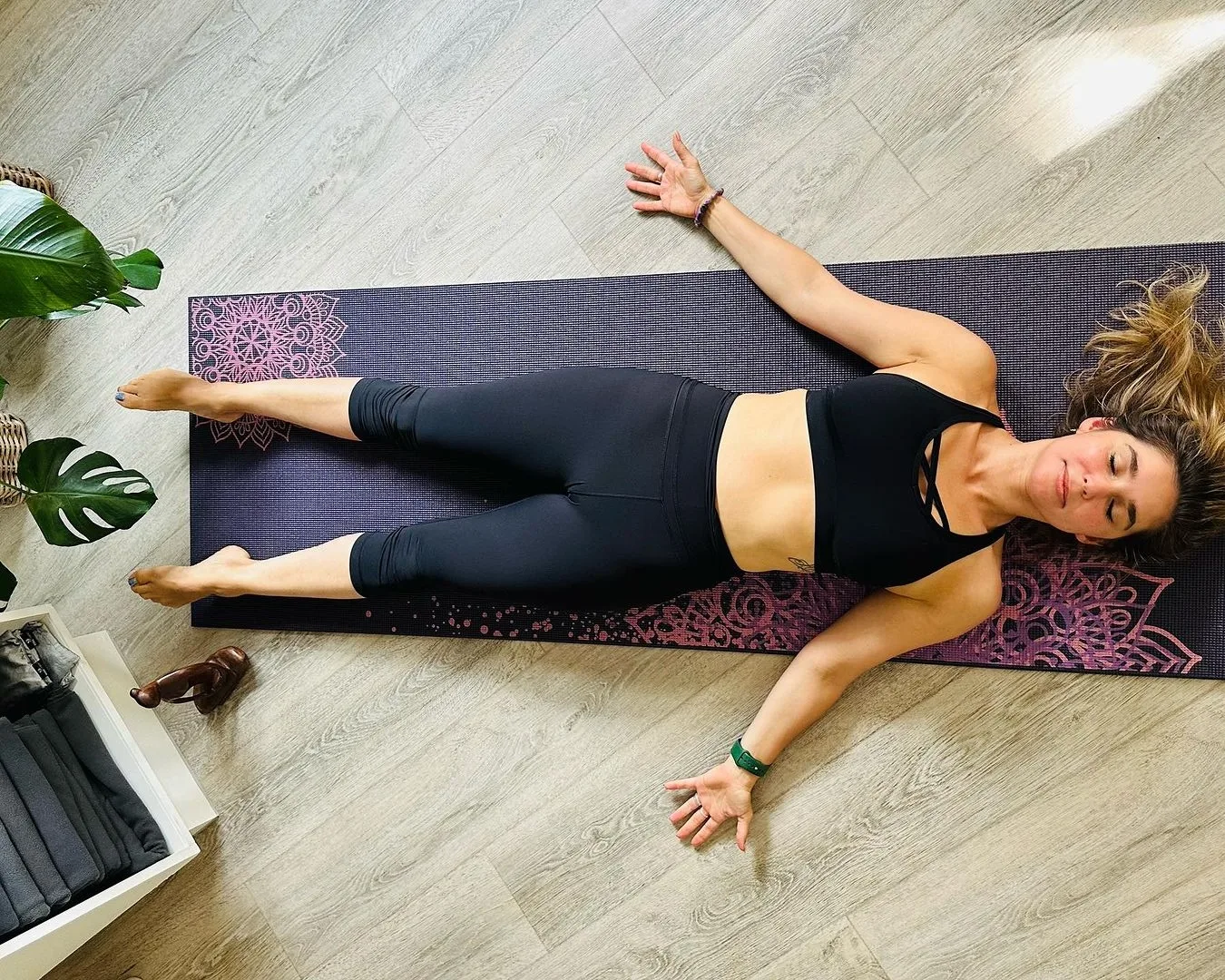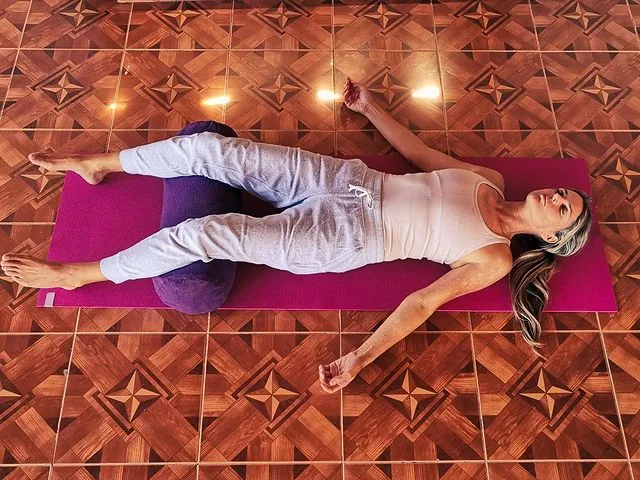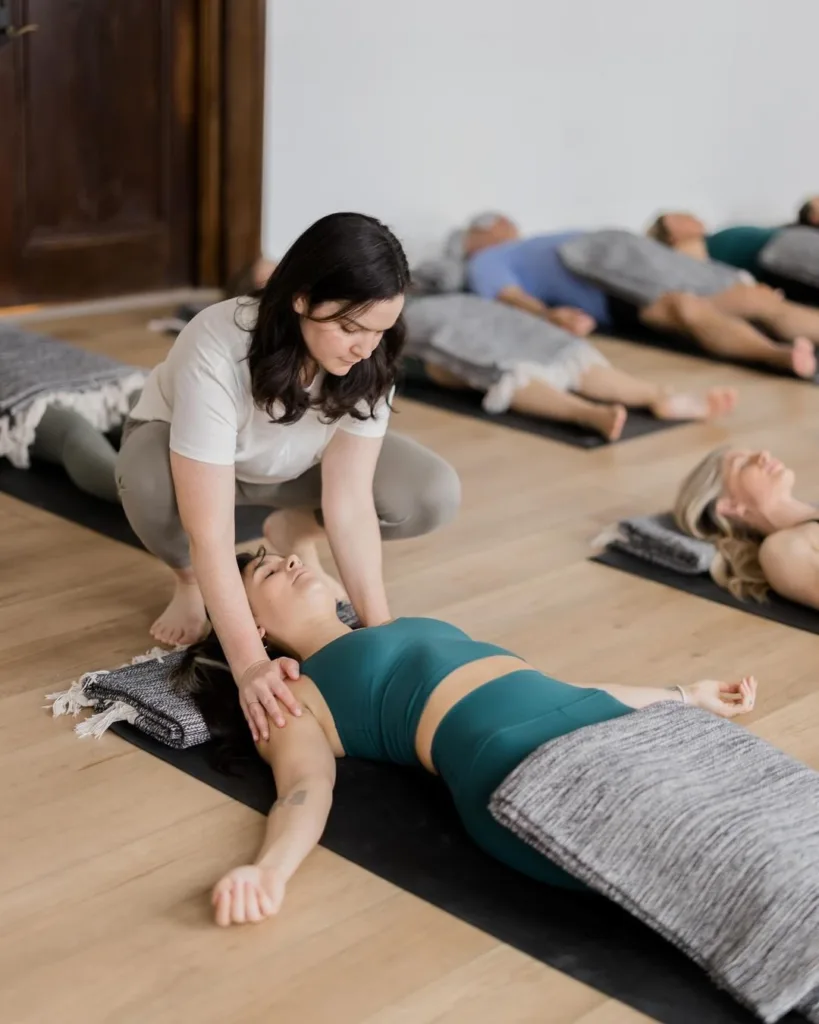Have you ever encountered a pose named “Savasana, Shavasana, or Mritasana (शवासन; मृतासन)” – literally translated as “corpse pose” – and thought, “This doesn’t sound very relaxing”? Don’t be fooled! Savasana, far from being a passive ending to a yoga practice, is a powerful gateway to profound relaxation and rejuvenation. It’s a time for your body to fully integrate the benefits of your movements, allowing your mind to settle into a state of tranquil awareness.
In This Article
What is Savasana?
Savasana, also known as Corpse Pose (Mritasana), is a foundational asana (pose) in hatha yoga and modern yoga practices.
In Sanskrit, “Savasana” translates to “Corpse Pose,” with “Sava” meaning “corpse” and “asana” meaning “pose” or “posture.”
In Savasana, practitioners lie flat on their backs with their arms relaxed by their sides, palms facing up, and legs slightly apart. The body is in a state of complete stillness, mimicking the repose of a corpse, hence the name.
While it may seem simple, Savasana is considered one of the most challenging poses in yoga due to the discipline required to fully relax both the body and mind. Despite its apparent passivity, Savasana is an active form of relaxation where practitioners focus on consciously releasing tension from every part of their body, surrendering to the present moment, and allowing the mind to become tranquil.
Savasana serves as a profound opportunity for integration and assimilation of the benefits accrued throughout the yoga practice. It allows practitioners to absorb the physical, mental, and emotional effects of the preceding postures, promoting deep relaxation, stress relief, and a sense of inner peace.
Dive Deeper: The Power of Savasana in Deep Relaxation and Restorative Sleep
Savasana is far more than a simple rest at the end of your yoga session. It’s a gateway to deep relaxation, a foundation for restorative sleep, and a wellspring of calm amidst the chaos of daily life.
By quieting the mind and relaxing the body, Savasana paves the way for uninterrupted, rejuvenating slumber. If you battle insomnia, this pose could be your secret weapon, helping you slip effortlessly into a night of peaceful rest.
Modern life layers stress upon stress. Savasana washes those layers away with a gentle current of relaxation, offering a soothing sanctuary for your overwhelmed mind. It fosters emotional well-being and leaves you feeling calm and centered.
Despite its death-like appearance, Savasana doesn’t induce lethargy. It revitalizes both body and mind. Releasing physical tension and calming the nervous system, Savasana replenishes your energy reserves, leaving you invigorated and ready to face the day with renewed focus.
The Benefits of Savasana (Corpse Pose)
Savasana isn’t just about feeling relaxed. It produces tangible physical and mental benefits when incorporated into your yoga routine:
1. Physical Benefits
Reduces Fatigue:
- By allowing the body to fully relax, Savasana helps alleviate feelings of fatigue and exhaustion accumulated throughout the day.
- Evidence suggests that deep relaxation techniques like Savasana can decrease feelings of tiredness and increase overall energy levels. 1 2 3
Lowers Blood Pressure:
- Savasana promotes relaxation of the cardiovascular system, leading to a reduction in blood pressure.
- Studies have shown that regular practice of Savasana can contribute to lower blood pressure levels, which is beneficial for heart health. 3 4 5
Relaxes and Rejuvenates the Body:
- Through conscious relaxation of muscles and deep breathing, Savasana facilitates the release of tension and promotes overall rejuvenation of the body.
- Research indicates that practicing Savasana regularly can enhance feelings of relaxation and well-being, contributing to overall physical health. 6 7
2. Mental Benefits
Calms and Centers the Mind:
- Savasana encourages mental relaxation and helps calm the incessant chatter of the mind.
- Scientific studies have demonstrated that Savasana can promote a state of mental tranquility and improve focus and concentration. 8 7 6
Reduces Insomnia:
- By inducing a state of deep relaxation, Savasana can help individuals struggling with insomnia to fall asleep more easily and experience more restful sleep.
- Research suggests that incorporating Savasana into a nightly routine can improve sleep quality and duration. 9 10
Reduces Stress:
- Savasana serves as an effective stress management tool by activating the parasympathetic nervous system and promoting relaxation.
- Studies have shown that regular practice of Savasana can reduce levels of stress hormones such as cortisol, leading to decreased feelings of stress and anxiety. 11 12 13 14
Relieves Mild Depression and Anxiety:
- The profound relaxation experienced during Savasana can alleviate symptoms of mild depression and anxiety by promoting feelings of calmness and well-being.
- Scientific evidence supports the use of relaxation techniques like Savasana as complementary therapies for managing mood disorders. 6 15 16
Bottom line
Whether seeking better sleep, stress reduction, or simple rejuvenation, Savasana offers a powerful and accessible path to deep relaxation and renewal. Make it a part of your yoga routine and experience its transformative benefits for your body and mind.
Mastering the Art of Savasana: A Step-by-Step Guide
Savasana (Corpse Pose) offers profound relaxation when done correctly. Here’s how to find true rest in this deceptively simple yoga pose:
1. Create Your Perfect Savasana Sanctuary
Creating an optimal environment is paramount for deep relaxation. From soft lighting to comfortable props, curate a space conducive to tranquility, free from distractions that may disrupt your practice.
2. Assuming the Pose
Proper alignment is key to reaping the full benefits of Savasana. Lie flat on your back, arms relaxed by your sides, palms facing up. Close your eyes and focus on each part of your body, consciously releasing tension as you sink into stillness.
3. The Practice Guide
Savasana or Mritasana

Instructions:
- Sit on the floor with your legs bent, feet flat.
- Come down on your elbows. Lift your pelvis an inch or two off the floor, and bend your hips toward the cat’s flank, rotating the pelvis backward.
- Then, keeping your pelvis in cat’s tilt, lower your lower back and sacrum to the floor again and allow them to rest on the floor.
- Lie straight, take your elbows to the side and slowly lower your back to the floor. Extend your arms out to your sides away from your body, palms up, then arch your back and shoulders, flatten the shoulder blades, and feel comfortable with yourself. Rest on the center point at the back of your skull.
- Straighten your legs one by one. Stand with your feet about shoulder-width apart, and allow them to fall outward.
- Check that your feet are comfortably away, your arms are comfortably away from your body, and your head is straight.
- Close your eyes, find your perfect alignment, then allow yourself to relax and do nothing for the next 3-20 minutes.
Savasana with bolster under knees

Instructions:
- Take Savasana (Corpse Pose). Sit with your legs extended and your hands by your side.
- Use a bolster under the knees to create a slight flexion, while relaxing the hamstrings. You can also place a blanket under the head to gently flex the cervical area.
- Alternatively, place a block in the area of the shoulder blades to passively stretch the intercostal muscles and expand the chest. Avoid stretching the neck as it tightens the neck and can damage the cervical spine area. Instead, use a block under the head to gently flex the neck.
- Allow the feet to face outwards and the palms facing up. To complete your practice, close your eyes and rest in Shavasana for 3 to 10 minutes.
4. Tips and Tricks
Step-1
- Keep the techniques simple. Relax everywhere—and then be aware of how you feel.
- Voluntarily put aside your worries, fears, and worries of the day, and let go of every obvious sign of tension in your body—and then be aware of how you feel.
Step-2
- Become more aware of tensions where your body is uncomfortable or tight, and consciously release them and relax to feel how it feels.
- Experience being completely relaxed, unrestricted, and wide awake.
Step-3
- Shavasana is a way to find relief and experience the self.
- The essence of yoga: to go in and experience the self.
Step-4
- Scan your awareness around and through your body, alert you to where there is unnecessary contraction, restlessness, tension, or excessive energy. Let go of every sign of stopping.
Step-5
- Start with your hands. Relax your awareness in the area of your hands and feel the energy in your hands.
- Feel the warmth or tingling sensation in your hands as they relax.
Step-6
- Feel your hands expanding and becoming less dense, less thick, less shriveled.
- Let them expand without limits and enjoy the sensation.
Step-7
- Let this feeling flow through your arms at your leisurely pace upwards, until your arms, hands, and shoulders feel relaxed, transparent, clear.
Step-8
- Direct your attention to your feet. Relax the soles of each foot, the arches, and the toes.
- Feel the energy in your feet and let it flow upwards through your legs.
Step-9
- Allow the tingling sensation to flow slowly upward through your legs, torso, and head – until your entire body is able to respond to experiencing this pleasant tingling vibration.
Step-10
- Relax your legs, abdomen, pelvis, and buttocks.
- Allow your awareness to move throughout this area at your own comfortable pace and enjoy the sensation.
Step-11
- Relax your stomach and abdomen, and allow your breathing to be normal, free, unrestricted.
- Feel your belly rise and fall with each breath and ride the breath.
Step-12
- Relax your lower back, diaphragm, ribs, chest, and heart.
- Leave every sign of holding and let go completely.
Step-13
- Relax your neck, throat, face, and head. Relax your mouth, lips, jaw, nose, cheeks, ears, and eyes.
- Soften every tension and feel the energy in your face.
Step-14
- Feel the space inside your body and the space around your body.
- Release every tension and experience the sensation of wide open space.
Step-15
- Feel the peace of peace and experience the stillness of Infinite Being.
- Relax and feel the joy of deep, healing peace.
Step-16
- Feel yourself expanding as you relax and experience the infinite nature of your being.
- Relax and feel the peace of infinite existence.
Step-17
- Experience a whole new sense of identity and realize your true nature.
- Relax and feel the joy of being.
Step-18
- Release every tension and experience the natural ease or joy of being.
- Relax and feel the comfort of pure conscious awareness.
Step-19
- Relax and feel what is happening where you are and take ease in the idea that you are consciousness.
- Surrender, merge, and rest in yourself.
Step-20
- Relax and feel the peace of deep inner peace.
- Enjoy the sensation of wide open space.
Step-21
- Keep it simple: Relax, feel, and see what happens.
- Stay in the experience and pay attention to what’s really happening right now.
Step-22
- Enjoy the way you feel and allow yourself to become completely familiar with how it feels to be completely relaxed.
- Let the deeply soothing experience of deep inner peace saturate your conscious awareness.
Step-23
- When you’ve had enough, prepare yourself and open your eyes.
- Be relaxed, spacious, unrestricted, and wide open, and enjoy the sensation of being fully present in the moment.
Precautions and Considerations
While Savasana has immense benefits, it’s important to be aware of certain situations where the pose may be less comfortable or require modifications:
- Difficulty Finding Stillness: If you find it extremely challenging to relax your mind or body, forcing the pose can be counterproductive. Instead, try guided relaxation techniques or consult a yoga instructor for tailored guidance.
- Physical Pain or Discomfort: If you’re experiencing significant pain, it might be difficult to reap the benefits of Savasana. Modify the pose using props or focus on gentle relaxation techniques until your pain subsides.
- Severe Acidity: Lying flat on your back may worsen acid reflux. Consider a slightly inclined position or try an alternative relaxation pose.
- Lower Back Issues: If you have a lower back injury, bending your knees and placing your feet flat on the floor might provide better support and comfort.
Savasana is generally safe for most people. However, it’s always a good idea to listen to your body and modify the pose as needed. If you experience discomfort or have health concerns, consult a doctor or a qualified yoga instructor for personalized advice.
Additional Considerations
- Mental Restlessness: A busy mind is normal. Gently acknowledge your thoughts and return your attention to your breath and body.
- Pregnancy: During later stages of pregnancy, lying flat may be uncomfortable. Consider using a bolster or pillows to support your side.
Beyond the Basics: Reaching the Full Potential of Savasana
Savasana isn’t just about passively lying still. It offers an opportunity to go beyond mere physical stillness and cultivate a deeper state of mindful relaxation. Integrate simple meditation techniques by focusing on your breath, the sensations within your body, or repeating a calming mantra.
Let guided imagery transport you to a place of tranquility. Imagine yourself on a peaceful beach, surrounded by a lush forest, or immersed in any setting that evokes serenity. Engage your senses within this visualization, allowing inner tension to dissolve and a profound sense of relaxation to wash over you.
A Practice for Everyone, Anytime, Anywhere
- Debunking Myths: Don’t let misconceptions like “Shavasana is a waste of time,” or “It’s only for experienced yogis” deter you. This pose is accessible to everyone, offering benefits regardless of your fitness level.
- Finding Moments of Stillness: Incorporating this asana into your busy life doesn’t require hours of dedication. Even a few minutes of mindful relaxation before bed, during a break, or right after waking can have a profound impact.
Conclusion
In the hustle and bustle of modern life, the profound simplicity of Savasana offers a sanctuary of stillness amidst the chaos. Its transformative potential transcends the confines of the yoga mat, permeating every facet of our existence. As you continue on your paths of self-discovery and renewal, let Corpse Pose be your guiding light, illuminating the path to deep relaxation and overall well-being. Believe in its power, and watch as it transforms your life, one breath at a time.
FAQs
- T. K. BERA*, M. M. GORE AND J. P. OAK. “RECOVERY FROM STRESS IN TWO DIFFERENT POSTURES AND IN SHAVASANA – A YOGIC RELAXATION POSTURE.” Scientific Research Department, Kaivalyadhama S.M. Y.M. Samiti, Lonavla 410 403. Indian J Physiol Pharmacol 1998; 42 (4) : 473-478. Available from: https://www.ijpp.com/IJPP/20archives/1998_42_4/473-478.[↩]
- Bera TK, Gore MM, Oak JP. “Recovery from stress in two different postures and in Shavasana–a yogic relaxation posture.” Indian J Physiol Pharmacol. 1998 Oct;42(4):473-8. PMID: 10874346.[↩]
- Sharma, G., Mahajan, K. K., & Sharma, L. (2007, April 1). “Shavasana—Relaxation technique to combat stress.” Journal of Bodywork and Movement Therapies. doi: 10.1016/j.jbmt.2007.01.002.[↩][↩]
- Chauhan A, Semwal DK, Mishra SP, Semwal RB. “Yoga Practice Improves the Body Mass Index and Blood Pressure: A Randomized Controlled Trial.” Int J Yoga. 2017 May-Aug;10(2):103-106. doi: 10.4103/ijoy.IJOY_46_16. PMID: 28546682; PMCID: PMC5433109.[↩]
- Hagins M, States R, Selfe T, Innes K. “Effectiveness of yoga for hypertension: systematic review and meta-analysis.” Evid Based Complement Alternat Med. 2013;2013:649836. doi: 10.1155/2013/649836. Epub 2013 May 28. PMID: 23781266; PMCID: PMC3679769.[↩]
- Woodyard C. “Exploring the therapeutic effects of yoga and its ability to increase quality of life.” Int J Yoga. 2011 Jul;4(2):49-54. doi: 10.4103/0973-6131.85485. PMID: 22022122; PMCID: PMC3193654.[↩][↩][↩]
- Alexander GK, Innes KE, Selfe TK, Brown CJ. “More than I expected”: perceived benefits of yoga practice among older adults at risk for cardiovascular disease. Complement Ther Med. 2013 Feb;21(1):14-28. doi: 10.1016/j.ctim.2012.11.001. Epub 2012 Nov 29. PMID: 23374201; PMCID: PMC3564012.[↩][↩]
- Shroff FM, Asgarpour M (2017) Yoga and Mental Health: A Review. Physiother Rehabil 2: 132. doi:10.4172/2573-0312.1000132.[↩]
- Mustian KM, Sprod LK, Janelsins M, Peppone LJ, Palesh OG, Chandwani K, Reddy PS, Melnik MK, Heckler C, Morrow GR. “Multicenter, randomized controlled trial of yoga for sleep quality among cancer survivors.” J Clin Oncol. 2013 Sep 10;31(26):3233-41. doi: 10.1200/JCO.2012.43.7707. Epub 2013 Aug 12. PMID: 23940231; PMCID: PMC3757292.[↩]
- A routine within a routine: can bedtime yoga improve sleep for the whole family? | SportRxiv. (n.d.). DOI:10.51224/SRXIV.328.[↩]
- Pascoe, M., & Thompson, D. R. (2017, December 1). Yoga, mindfulness-based stress reduction and stress-related physiological measures: A meta-analysis. Psychoneuroendocrinology. doi: 10.1016/j.psyneuen.2017.08.008.[↩]
- Thirthalli J, Naveen GH, Rao MG, Varambally S, Christopher R, Gangadhar BN. “Cortisol and antidepressant effects of yoga.” Indian J Psychiatry. 2013 Jul;55(Suppl 3):S405-8. doi: 10.4103/0019-5545.116315. PMID: 24049209; PMCID: PMC3768222.[↩]
- Katuri KK, Dasari AB, Kurapati S, Vinnakota NR, Bollepalli AC, Dhulipalla R. “Association of yoga practice and serum cortisol levels in chronic periodontitis patients with stress-related anxiety and depression.” J Int Soc Prev Community Dent. 2016 Jan-Feb;6(1):7-14. doi: 10.4103/2231-0762.175404. PMID: 27011926; PMCID: PMC4784068.[↩]
- R P, Kumar AP, Dhamodhini K S, Venugopal V, Silambanan S, K M, Shah P. “Role of yoga in stress management and implications in major depression disorder.” J Ayurveda Integr Med. 2023 Sep-Oct;14(5):100767. doi: 10.1016/j.jaim.2023.100767. Epub 2023 Sep 21. PMID: 37741161; PMCID: PMC10520539.[↩]
- Norelli SK, Long A, Krepps JM. “Relaxation Techniques.” [Updated 2023 Aug 28]. In: StatPearls [Internet]. Treasure Island (FL): StatPearls Publishing; 2024 Jan-. Available from: https://www.ncbi.nlm.nih.gov/books/NBK513238/.[↩]
- Bridges L, Sharma M. “The Efficacy of Yoga as a Form of Treatment for Depression.” Journal of Evidence-Based Complementary & Alternative Medicine. 2017;22(4):1017-1028. doi: 10.1177/2156587217715927.[↩]



